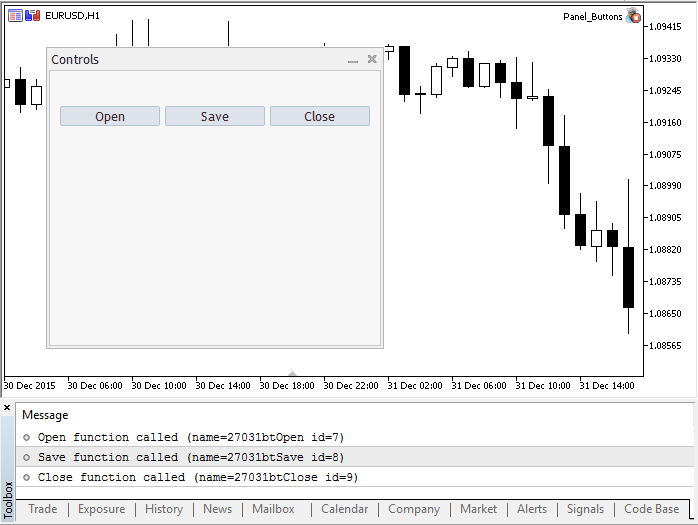//+------------------------------------------------------------------+
//| Panel_Buttons.mq5 |
//| Copyright 2017, MetaQuotes Software Corp. |
//| https://www.mql5.com |
//+------------------------------------------------------------------+
#property copyright "Copyright 2017, MetaQuotes Software Corp."
#property link "https://www.mql5.com"
#property version "1.00"
#property description "The panel with several CButton buttons"
#include <Controls\Dialog.mqh>
#include <Controls\Button.mqh>
//+------------------------------------------------------------------+
//| 定义 |
//+------------------------------------------------------------------+
//--- 缩进和间隔
#define INDENT_LEFT (11) // 从左缩进(预留边框宽度)
#define INDENT_TOP (11) // 从上缩进(预留边框宽度)
#define CONTROLS_GAP_X (5) // X坐标间隔
#define CONTROLS_GAP_Y (5) // Y坐标间隔
//--- 按键
#define BUTTON_WIDTH (100) // X坐标大小
#define BUTTON_HEIGHT (20) // Y坐标大小
//--- 显示区域
#define EDIT_HEIGHT (20) // Y坐标大小
//--- 创建自定义函数类型
typedef int(*TAction)(string,int);
//+------------------------------------------------------------------+
//| 打开文件 |
//+------------------------------------------------------------------+
int Open(string name,int id)
{
PrintFormat("%s function called (name=%s id=%d)",__FUNCTION__,name,id);
return(1);
}
//+------------------------------------------------------------------+
//| 保存文件 |
//+------------------------------------------------------------------+
int Save(string name,int id)
{
PrintFormat("%s function called (name=%s id=%d)",__FUNCTION__,name,id);
return(2);
}
//+------------------------------------------------------------------+
//| 关闭文件 |
//+------------------------------------------------------------------+
int Close(string name,int id)
{
PrintFormat("%s function called (name=%s id=%d)",__FUNCTION__,name,id);
return(3);
}
//+------------------------------------------------------------------+
//| 通过事件处理函数创建按键类 |
//+------------------------------------------------------------------+
class MyButton: public CButton
{
private:
TAction m_action; // 图表事件处理程序
public:
MyButton(void){}
~MyButton(void){}
//--- 构造函数指定按键文本和事件处理函数指针
MyButton(string text,TAction act)
{
Text(text);
m_action=act;
}
//--- 设置OnEvent()事件处理程序调用的自定义函数
void SetAction(TAction act){m_action=act;}
//--- 标准图表事件处理程序
virtual bool OnEvent(const int id,const long &lparam,const double &dparam,const string &sparam) override
{
if(m_action!=NULL && lparam==Id())
{
//--- 调用自定义处理程序
m_action(sparam,(int)lparam);
return(true);
}
else
//--- 返回调用CButton父类处理程序的结果
return(CButton::OnEvent(id,lparam,dparam,sparam));
}
};
//+------------------------------------------------------------------+
//| CControlsDialog 类 |
//| 目标:管理应用程序的图形面板 |
//+------------------------------------------------------------------+
class CControlsDialog : public CAppDialog
{
private:
CArrayObj m_buttons; // 按键数组
public:
CControlsDialog(void){};
~CControlsDialog(void){};
//--- 创建
virtual bool Create(const long chart,const string name,const int subwin,const int x1,const int y1,const int x2,const int y2) override;
//--- 添加按键
bool AddButton(MyButton &button){return(m_buttons.Add(GetPointer(button)));m_buttons.Sort();};
protected:
//--- 创建按键
bool CreateButtons(void);
};
//+------------------------------------------------------------------+
//| 在图表上创建CControlsDialog 对象 |
//+------------------------------------------------------------------+
bool CControlsDialog::Create(const long chart,const string name,const int subwin,const int x1,const int y1,const int x2,const int y2)
{
if(!CAppDialog::Create(chart,name,subwin,x1,y1,x2,y2))
return(false);
return(CreateButtons());
//---
}
//+------------------------------------------------------------------+
//| 创建和添加按键到CControlsDialog面板 |
//+------------------------------------------------------------------+
bool CControlsDialog::CreateButtons(void)
{
//--- 计算按键坐标
int x1=INDENT_LEFT;
int y1=INDENT_TOP+(EDIT_HEIGHT+CONTROLS_GAP_Y);
int x2;
int y2=y1+BUTTON_HEIGHT;
//--- 添加带有函数指针的按键对象
AddButton(new MyButton("Open",Open));
AddButton(new MyButton("Save",::Save));
AddButton(new MyButton("Close",Close));
//--- 创建图形按键
for(int i=0;i<m_buttons.Total();i++)
{
MyButton *b=(MyButton*)m_buttons.At(i);
x1=INDENT_LEFT+i*(BUTTON_WIDTH+CONTROLS_GAP_X);
x2=x1+BUTTON_WIDTH;
if(!b.Create(m_chart_id,m_name+"bt"+b.Text(),m_subwin,x1,y1,x2,y2))
{
PrintFormat("Failed to create button %s %d",b.Text(),i);
return(false);
}
//--- 添加每个按键到CControlsDialog 集合
if(!Add(b))
return(false);
}
//--- 成功
return(true);
}
//--- 声明全局对象以便在启动程序时自动创建
CControlsDialog MyDialog;
//+------------------------------------------------------------------+
//| EA交易初始化函数 |
//+------------------------------------------------------------------+
int OnInit()
{
//--- 现在,在图表上创建对象
if(!MyDialog.Create(0,"Controls",0,40,40,380,344))
return(INIT_FAILED);
//--- 启动应用程序
MyDialog.Run();
//--- 应用程序成功初始化
return(INIT_SUCCEEDED);
}
//+------------------------------------------------------------------+
//| EA交易去初始化函数 |
//+------------------------------------------------------------------+
void OnDeinit(const int reason)
{
//--- 销毁对话框
MyDialog.Destroy(reason);
}
//+------------------------------------------------------------------+
//| EA交易图表事件函数 |
//+------------------------------------------------------------------+
void OnChartEvent(const int id, // 事件 ID
const long& lparam, // long型事件参数
const double& dparam, // double型事件参数
const string& sparam) // string型事件参数
{
//--- 调用图表事件父类(这里是CAppDialog)的处理程序
MyDialog.ChartEvent(id,lparam,dparam,sparam);
}
|
